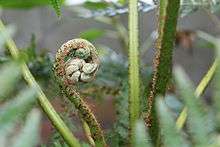Cyathea capensis
| Cyathea capensis | |
|---|---|
| | |
| Cyathea capensis ssp. capensis growing in Afromontane forest in Cape Town. | |
| Scientific classification | |
| Kingdom: | Plantae |
| Division: | Pteridophyta |
| Class: | Pteridopsida |
| Order: | Cyatheales |
| Family: | Cyatheaceae |
| Genus: | Cyathea |
| Subgenus: | Cyathea |
| Section: | Alsophila |
| Species: | C. capensis |
| Binomial name | |
| Cyathea capensis (Linnaeus fil.) J. E. Smith, 1793 | |
| Subspecies | |
| |
| Synonyms | |
| |
Cyathea capensis, with the common name Forest tree fern, is a regionally widespread and highly variable species of tree fern. [1][2]
Distribution
This fern is the only memeber of the family Cyatheaceae native to both Africa and the Americas. The species is divided into two subspecies:
- Cyathea capensis subsp. capensis
Cyathea capensis subsp. capensis is native to the Old World tropics in Africa. It is found in Malawi, Mozambique, Tanzania, Swaziland, Zimbabwe, and South Africa (from the Western Cape province to KwaZulu-Natal and Mpumalanga).
It grows in shaded moist forest along rivers and beside waterfalls, at altitudes of 360–1,820 metres (1,180–5,970 ft). The specific epithet capensis refers to the Cape of Good Hope in South Africa, where the type specimen was collected.
- Cyathea capensis subsp. polypodioides
Cyathea capensis subsp. polypodioides is native to the New World tropics in South America.
It is endemic to southeastern Brazil in montane Atlantic Forest habitats, at altitudes of 900–2,000 metres (3,000–6,600 ft).
Description
Cyathea capensis (both subspecies) has an erect trunk is up to 4.5 metres (15 ft)tall, occasionally even 6 metres (20 ft), and about 15 cm in diameter.
Fronds are pinnate and 2-3 m in length. The lowest pinnae may be separated from the others along the rachis and form a clump around the crown, similar to the "wig" of Cyathea baileyana. The rachis is smooth to slightly warty and covered in scales that range from tan to brown or dark brown.
Sori occur in two rows, one along each side of the pinnule midvein, and are covered by scale-like indusia.
Cultivation
Cyathea capensis is cultivated as an ornamental plant. [3] It is relatively easy to grow if provided with a semi-shady, moist and sheltered environment, and can likely tolerate several degrees of frost. [3]

References
- ↑ The International Plant Names Index: Cyathea capensis
- ↑ Braggins, John E. & Large, Mark F. 2004. Tree Ferns. Timber Press, Inc., pp. 109–110. ISBN 0-88192-630-2
- 1 2 Cold-Hardy Tree Ferns: Cyathea capensis
| Wikimedia Commons has media related to Cyathea capensis. |